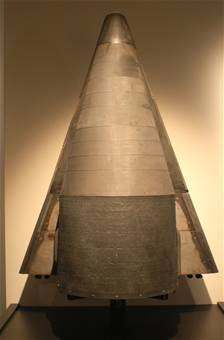- ASSET (spaceplane)
infobox Aircraft
name = ASSET
type =Spaceplane
manufacturer =McDonnell Aircraft 
caption = Preserved ASSET vehicle at USAF Museum, Dayton, Ohio
designer =
first flight =September 18 ,1963
introduced =
retired =
produced =
number built = 6
status = Museum piece
unit cost =
primary user =United States Air Force
more users =
developed from =X-20 Dyna-Soar
variants with their own articles = Winged GeminiASSET, or Aerothermodynamic Elastic Structural Systems Environmental Tests was an experimental US space project involving the testing of an unmanned subscale reentry vehicle.
Development and Testing
Begun in 1960, ASSET was originally designed to verify the superalloy heatshield of the
X-20 Dyna-Soar prior to fullscale manned flights. The vehicle's biconic shape and low delta wing was intended to represent Dyna-Soar's forward nose section, where the aerodynamic heating would be the most intense; in excess of an estimated 4,000-deg.F at the nosecap.Following the X-20 program's cancellation in December 1963, completed ASSET vehicles were used in reentry heating and structural investigations in the hopes that data gathered would be useful for the development of future space vehicles, such as theSpace Shuttle .Built by
McDonnell , each vehicle was launched on a suborbital trajectory from Cape Canaveral's Pad 17B at speeds of up to 6,000 m/s before making a water landing in the South Atlantic nearAscension Island . Originally, a Scout launch vehicle had been planned for the tests, but this was changed after a large surplus of Thor and Thor-Delta missiles returned from theUnited Kingdom became available.Of the six vehicles built, only one was successfully recovered and is currently on display at the
National Museum of the United States Air Force inDayton, Ohio .Flights
pecifications
aircraft specifications
plane or copter?=plane
jet or prop?=jet
ref=
crew=None
capacity=
payload main=
payload alt=
length main= 5.74 ft
length alt= 1.75 m
span main= 4.57 ft
span alt= 1.39 m
height main= 2.73 ft
height alt= 0.83 m
area main=
area alt=
airfoil=
empty weight main=
empty weight alt=
loaded weight main= 1,190 lb
loaded weight alt= 540 kg
useful load main=
useful load alt=
max takeoff weight main=
max takeoff weight alt=
more general=
engine (jet)=Hydrogen-peroxide reaction control thrusters
type of jet=
number of jets=
thrust main=
thrust alt=
thrust original=
afterburning thrust main=
afterburning thrust alt=
max speed main=Mach 25
max speed alt=
cruise speed main=
cruise speed alt=
stall speed main=
stall speed alt=
never exceed speed main=
never exceed speed alt=
range main= 2,700 miles
range alt= 4345.2288 km
ceiling main= 50 miles
ceiling alt= 80.4672 km
climb rate main=
climb rate alt=
loading main=
loading alt=
thrust/weight=
power/mass main=
power/mass alt=
more performance=
* Hypersonic L/D Ratio: 1:1
armament=
avionics=Related content
Comparable Aircraft
*Molniya BOR-4
*Martin-Marietta X-23 PRIMEWinged Gemini
In the mid-1960s,
McDonnell proposed a variant of the Gemini capsule which retained the original spacecraft's internal subsytems and crew compartment, but which dispensed with the tail-first ballistic reentry, parachute recovery and water landing.Instead, the vehicle would be heavily modified externally into an ASSET-like lifting-reentry configuration. Post-reentry, a pair of stowed swing-wings would be deployed, giving the spacecraft sufficient L/D to make a piloted glide landing on a concrete runway using a skid-type landing gear (reinstated from the planned, but cancelled paraglider landing system), much like today's Space Shuttle.
According to Mark Wade's Encyclopedia Astronautica, the intent seems to have been to field a manned military spaceplane at a minimal cost following the cancellation of the Dyna-Soar program.
External links
* [http://www.astronautix.com/craft/asset.htm ASSET at Encyclopedia Astronautica]
* [http://www.astronautix.com/craft/winemini.htm Winged Gemini at Encyclopedia Astronautica]
Wikimedia Foundation. 2010.
